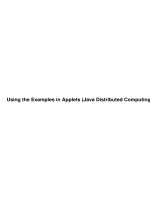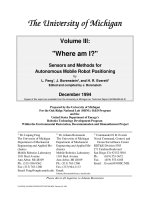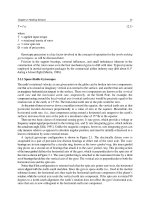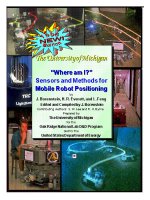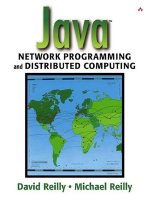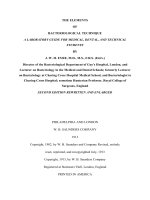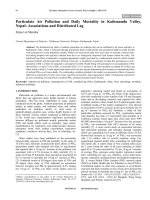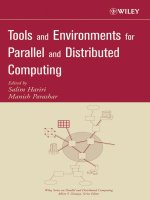TOOLS AND ENVIRONMENTS FOR PARALLEL AND DISTRIBUTED COMPUTING pptx
Bạn đang xem bản rút gọn của tài liệu. Xem và tải ngay bản đầy đủ của tài liệu tại đây (2.41 MB, 229 trang )
TOOLS AND ENVIRONMENTS
FOR PARALLEL AND
DISTRIBUTED COMPUTING
Edited by
Salim Hariri
Manish Parashar
A JOHN WILEY & SONS, INC., PUBLICATION
TOOLS AND ENVIRONMENTS
FOR PARALLEL AND
DISTRIBUTED COMPUTING
WILEY SERIES ON PARALLEL AND DISTRIBUTED COMPUTING
Series Editor: Albert Y. Zomaya
Parallel and Distributed Simulation Systems / Richard Fujimoto
Surviving the Design of Microprocessor and Multimicroprocessor Systems:
Lessons Learned / Veljko Milutinovic´
Mobile Processing in Distributed and Open Environments / Peter Sapaty
Introduction to Parallel Algorithms / C. Xavier and S. S. Iyengar
Solutions to Parallel and Distributed Computing Problems: Lessons from
Biological Sciences / Albert Y. Zomaya, Fikret Ercal, and Stephan Olariu (Editors)
New Parallel Algorithms for Direct Solution of Linear Equations /
C. Siva Ram Murthy, K. N. Balasubramanya Murthy, and Srinivas Aluru
Practical PRAM Programming / Joerg Keller, Christoph Kessler, and
Jesper Larsson Traeff
Computational Collective Intelligence / Tadeusz M. Szuba
Parallel and Distributed Computing: A Survey of Models, Paradigms, and
Approaches / Claudia Leopold
Fundamentals of Distributed Object Systems: A CORBA Perspective /
Zahir Tari and Omran Bukhres
Pipelined Processor Farms: Structured Design for Embedded Parallel
Systems / Martin Fleury and Andrew Downton
Handbook of Wireless Networks and Mobile Computing /
Ivan Stojmenovic´ (Editor)
Internet-Based Workflow Management: Toward a Semantic Web /
Dan C. Marinescu
Parallel Computing on Heterogeneous Networks / Alexey L. Lastovetsky
Tools and Environments for Parallel and Distributed Computing /
Salim Hariri and Manish Parashar (Editors)
TOOLS AND ENVIRONMENTS
FOR PARALLEL AND
DISTRIBUTED COMPUTING
Edited by
Salim Hariri
Manish Parashar
A JOHN WILEY & SONS, INC., PUBLICATION
Copyright © 2004 by John Wiley & Sons, Inc. All rights reserved.
Published by John Wiley & Sons, Inc., Hoboken, New Jersey.
Published simultaneously in Canada.
No part of this publication may be reproduced, stored in a retrieval system, or transmitted in
any form or by any means, electronic, mechanical, photocopying, recording, scanning, or
otherwise, except as permitted under Section 107 or 108 of the 1976 United States Copyright
Act, without either the prior written permission of the Publisher, or authorization through
payment of the appropriate per-copy fee to the Copyright Clearance Center, Inc., 222
Rosewood Drive, Danvers, MA 01923, 978-750-8400, fax 978-646-8600, or on the web at
Permissions Department, John Wiley & Sons, Inc., 111 River Street, Hoboken, NJ 07030,
(201) 748-6011, fax (201) 748-6008.
Limit of Liability/Disclaimer of Warranty: While the publisher and author have used their best
efforts in preparing this book, they make no representations or warranties with respect to the
accuracy or completeness of the contents of this book and specifically disclaim any implied
warranties of merchantability or fitness for a particular purpose. No warranty may be created
or extended by sales representatives or written sales materials. The advice and strategies
contained herein may not be suitable for your situation. You should consult with a professional
where appropriate. Neither the publisher nor author shall be liable for any loss of profit or any
other commercial damages, including but not limited to special, incidental, consequential, or
other damages.
For general information on our other products and services please contact our Customer
Care Department within the U.S. at 877-762-2974, outside the U.S. at 317-572-3993 or fax
317-572-4002.
Wiley also publishes its books in a variety of electronic formats. Some content that appears in
print, however, may not be available in electronic format.
Library of Congress Cataloging-in-Publication Data:
Hariri, Salim.
Tools and environments for parallel and distributed
computing / Salim Hariri & Manish Parashar.
p. cm.
ISBN 0-471-33288-7 (Cloth)
1. Parallel processing (Electronic computers) 2. Electronic data
processing—Distributed processing. I. Parashar, Manish, 1967– II.
Title.
QA76.58.H37 2004
004¢.35—dc21 2003014209
Printed in the United States of America.
10987654321
www.copyright.com. Requests to the Publisher for permission should be addressed to the
CONTENTS
Preface xi
1. Parallel and Distributed Computing 1
S. Hariri and M. Parashar
1.1 Introduction: Basic Concepts 1
1.2 Promises and Challenges of Parallel and
Distributed Systems 4
1.2.1 Processing Technology 5
1.2.2 Networking Technology 5
1.2.3 Software Tools and Environments 6
1.3 Distributed System Design Framework 6
References and Further Reading 8
2. Message-Passing Tools 11
S. Hariri and I. Ra
2.1 Introduction 11
2.2 Message-Passing Tools versus Distributed Shared Memory 12
2.2.1 Distributed Shared Memory Model 12
2.2.2 Message-Passing Model 12
2.3 Message-Passing System: Desirable Features 13
2.4 Classification of Message-Passing Tools 15
2.4.1 Classification by Implementation 17
2.5 Overview of Message-Passing Tools 19
2.5.1 Socket-Based Message Passing 19
2.5.2 p4 20
2.5.3 Parallel Virtual Machine 20
2.5.4 Message-Passing Interface 21
2.5.5 Nexus 22
2.5.6 Madeleine I and II 22
2.5.7 Active Messages 23
2.6 ACS 23
2.6.1 Multithread Communications Services 24
2.6.2 Separation of Data and Control Functions 24
v
2.6.3 Programmable Communication, Control, and
Management Service 26
2.6.4 Multiple Communication Interfaces 28
2.6.5 Adaptive Group Communication Services 29
2.7 Experimental Results and Analysis 29
2.7.1 Experimental Environment 30
2.7.2 Performance of Primitives 30
2.7.3 Application Performance Benchmarking 39
2.7.4 Performance Results of Adaptive Schemes 44
2.8 Conclusions 50
References 52
3. Distributed Shared Memory Tools 57
M. Parashar and S. Chandra
3.1 Introduction 57
3.2 Cache Coherence 59
3.2.1 Directory-Based Cache Coherence 59
3.3 Shared Memory Consistency Models 60
3.4 Distributed Memory Architectures 61
3.5 Classification of Distributed Shared Memory Systems 62
3.5.1 Hardware-Based DSM Systems 64
3.5.2 Mostly Software Page-Based DSM Systems 69
3.5.3 All-Software Object-Based DSM Systems 72
References 76
4. Distributed-Object Computing Tools 79
R. Raje, A. Kalyanaraman, and N. Nayani
4.1 Introduction 79
4.2 Basic Model 80
4.2.1 RMI 80
4.2.2 CORBA 81
4.2.3 DCOM 85
4.3 Examples 86
4.3.1 Experimental Setup 87
4.3.2 Developing Applications under RMI, CORBA,
and DCOM 87
4.3.3 Experiment 1: Ping 90
4.3.4 Experiment 2: Producer–Consumer Problem 103
4.3.5 Experiment 3: Numerical Computation 118
4.4 Comparison of the Three Paradigms 142
4.4.1 Dependency Issues 142
4.4.2 Implementation Details 142
vi CONTENTS
4.4.3 Architecture Details 142
4.4.4 Support for Additional Features 144
4.4.5 Performance Comparison 144
4.5 Conclusions 146
References 146
5. Gestalt of the Grid 149
G. von Laszewski and P. Wagstrom
5.1 Introduction 149
5.1.1 Motivation 150
5.1.2 Enabling Factors 151
5.2 Definitions 152
5.3 Multifaceted Grid Architecture 154
5.3.1 N-Tiered Grid Architecture 155
5.3.2 Role-Based Grid Architecture 155
5.3.3 Service-Based Grid Architecture 157
5.3.4 Grid Challenges 158
5.4 Grid Management Aspects 158
5.4.1 Managing Grid Security 159
5.4.2 Managing Grid Information 161
5.4.3 Managing Grid Data 161
5.4.4 Managing Grid Execution and Resources 162
5.4.5 Managing Grid Software 162
5.4.6 Managing Grid Hardware 163
5.5 Grid Activities 163
5.5.1 Community Activities 164
5.5.2 Grid Middleware 166
5.5.3 High-Throughput Computing 171
5.6 Grid Applications 175
5.6.1 Astrophysics Simulation Collaboratory 175
5.6.2 Particle Physics Data Grid 176
5.6.3 NEESgrid 177
5.7 Portals 177
5.7.1 HotPage 179
5.7.2 Webflow and Gateway 179
5.7.3 XCAT 180
5.7.4 UNICORE 180
5.7.5 JiPANG 181
5.7.6 PUNCH 181
5.7.7 Access Grid 182
5.7.8 Commercial Grid Activities 182
5.8 Conclusions 183
References 183
CONTENTS vii
6. Software Development for Parallel and Distributed Computing 189
M. Parashar and S. Hariri
6.1 Introduction 189
6.2 Issues in HPC Software Development 189
6.2.1 Models for Parallel Computation 190
6.2.2 Portable Application Description Medium 190
6.2.3 Parallel Algorithm Development 191
6.2.4 Program Implementation and Runtime 191
6.2.5 Visualization and Animation 191
6.2.6 Maintainability 192
6.2.7 Reliability 192
6.2.8 Reusability 192
6.3 HPC Software Development Process 192
6.4 Parallel Modeling of Stock Option Pricing 192
6.5 Inputs 194
6.6 Application Analysis Stage 195
6.7 Application Development Stage 198
6.7.1 Algorithm Development Module 198
6.7.2 System-Level Mapping Module 199
6.7.3 Machine-Level Mapping Module 200
6.7.4 Implementation/Coding Module 200
6.7.5 Design Evaluator Module 201
6.8 Compile-Time and Runtime Stage 201
6.9 Evaluation Stage 202
6.10 Maintenance/Evolution Stage 202
6.11 Existing Software Support 203
6.11.1 Application Specifications Filter 203
6.11.2 Application Analysis Stage 204
6.11.3 Application Development Stage 204
6.11.4 Compile-Time and Runtime Stage 204
6.11.5 Evaluation Stage 204
6.11.6 Maintenance/Evolution Stage 205
References 205
Index 209
viii CONTENTS
CONTRIBUTORS
Sumir Chandra, Department of Electrical and Computer Engineering,
Rutgers University, Piscataway, NJ 08854 (E-mail: )
Salim Hariri, Department of Electrical and Computer Engineering,
University of Arizona, Tucson, AZ 85721 (E-mail: )
A. Kalyanaraman, Department of Computer and Information Science,
Indiana University Purdue University, Indianapolis, IN
(E-mail: )
N. Nayani, Department of Computer and Information Science, Indiana
University Purdue University, Indianapolis, IN
(E-mail: )
Manish Parashar, Department of Electrical and Computer Engineering,
Rutgers University, Piscataway, NJ 08854
(E-mail: )
Ilkyeun Ra, Department of Computer Science and Engineering, University
of Colorado at Denver, Denver, CO 80217
(E-mail: )
Rajeev Raje, Department of Computer and Information Science, Indiana
University Purdue University, Indianapolis, IN
(E-mail: )
G. von Laszewski, Argonne National Laboratory, 9700 South Cass Avenue,
Argonne, IL 60439 (E-mail: )
P. Wagstrom, Department of Engineering and Public Policy, Carnegie Mellon
University, Pittsburgh, PA 15213 (E-mail: )
ix
PREFACE
The primary focus of this book is the rapidly evolving software technology for
supporting the development, execution, management, and experimentation
with parallel and distributed computing environments. The design, develop-
ment, and utilization of parallel and distributed computing environments that
can efficiently support a wide range of scientific and engineering applications
remains a challenging research problem due to the complexity and varying
requirements of the applications, heterogeneity of the computing systems and
their networks, asynchronous complex interactions among the system
and application components, and the heterogeneity of the software tools
and environments. However, recent advances in processing and network
technology and software tools have addressed successfully many of the obsta-
cles hindering the wide deployment of parallel and distributed computing
environments.
Active research in parallel processing has resulted in advances in all aspects
of the computing technologies, including processing technology, computer net-
working technology, and software technology. Advances in processing tech-
nology have resulted in faster, more powerful processors with increased
functionality. Advances in computer networking technology have introduced
reliable high-speed networks capable of providing high transfer rates.
Advances in software technology have provided easy-to use tools and envi-
ronments for the development of parallel applications. These advances have
resulted in the proliferation of a large number of different architectural
classes, such as SIMD computers, MIMD computers, vector computers, and
data flow computers, where each class represents a set of different trade-offs
in design decisions such as coarse-grained (MIMD) parallelism versus fine-
grained (SIMD) parallelism, shared memory MIMD versus distributed
memory MIMD, hypercube topology versus mesh topology, and
circuit-switched versus packet-switched communication. Each architectural
class is tuned to deliver maximum performance to a specific set of applica-
tions. However, it remains a fact that none of the existing computing systems
are general enough to address all classes of applications and provide the
desired performance levels. In addition, these architectures are not scalable
and their relatively narrow applicability has prevented them from being cost-
effective.
Furthermore, the development of efficient application software capable of
exploiting the available computing potential is nontrivial and requires a thor-
xi
ough understanding not only of the application, but also of the target com-
puting environment. Given the diversity of current computing systems and
their architectural complexity, this is not a reasonable proposition, especially
since application developers are not, in general, computer engineers. Even
porting existing applications to high-performance systems is nontrivial and
usually involves extensive redevelopment. As a result, the future of parallel
and distributed computing will be governed to a large extent by the availability
of sufficiently high-level languages, tools, and development environments that
can support application developers.
A key factor contributing to the complexity of parallel software develop-
ment is the increased degrees of freedom that have to be resolved and tuned
in such an environment.Typically,during the course of parallel software devel-
opment, the developer is required to select between available algorithms for
the particular application, between possible hardware configurations and
among possible decompositions of the problem onto the hardware configura-
tion selected, and between different communication and synchronization
strategies. The set of reasonable alternatives that have to be evaluated is very
large, and selecting the best alternative among these is a formidable task.
The current user has to spend considerable time in understanding the
details of the overall system as well as specific system aspects such as data
distribution, problem partitioning and scheduling, routing, load balancing,
efficient vectorization, efficient utilization of the memory hierarchy, and
synchronization, in order to achieve even a fraction of the theoretical peak
performance offered by the system. Consequently, there exists a significant dis-
proportion between the effort involved in developing an application algorithm
and in its efficient realization on any high-performance system.
It is this realization that has motivated the writing of this book. The goal of
the book is to serve as a reference for current software tools and technologies
that can be used to develop, implement, and support high-performance paral-
lel and distributed computing environments and applications. In this book we
review promising software tools and environments that play an important role
in the development of high-performance parallel/distributed systems and
applications, and highlight the salient features and limitations of these tools
and environments. Consequently, this book can serve as a useful reference for
researchers, educators, and practitioners in the field of parallel and distributed
computing, supercomputing, and networking.
The book is organized into six chapters; a brief summary is as follows.
Chapter 1: Parallel and Distributed Computing
This chapter provides an introduction to parallel and distributed systems and
their benefits in performance, resource sharing, extendibility, reliability, and
cost-effectiveness. It outlines parallel and distributed computing approaches
and paradigms and the opportunities and challenges of parallel and
xii PREFACE
distributed computing. Finally, it presents a three-tiered distributed system
design framework to highlight architectural issues, services, and candidate
technologies for implementing parallel/distributed computing systems and
applications.
Chapter 2: Message-Passing Tools
This chapter briefly reviews message-passing models for network-centric
applications. It presents the advantages of message-passing tools and their
classification with respect to the application domain, programming model
supported, communication model, portability, and adaptability. The chapter
describes hardware- and software-based approaches to improve the perfor-
mance of message-passing tools. This is followed by an overview of existing
message-passing tools such as socket-based message passing, p4, Parallel
Virtual Machine (PVM), Message-Passing Interface (MPI), Nexus, Madeleine,
and Active Messages. The chapter then describes the design of ACS
(Adaptive Communication System), a multithreaded message-passing tool,
and presents an experimental evaluation of ACS and three different message-
passing tools (p4, PVM, and MPI) with respect to primitives and application
performance.
Chapter 3: Distributed Shared Memory Tools
This chapter presents tools and environments for distributed shared memory
(DSM), a software abstraction of shared memory on a distributed memory
multiprocessor or cluster of workstations. It outlines the properties and fea-
tures of DSM systems and classifies them based on their architectures. The
chapter then describes cache coherence protocols for hardware-based DSM
systems,including CC-NUMA,COMA, and S-COMA; hybrid schemes,includ-
ing R-NUMA and AS-COMA; and hardware-based environments, such as the
MIT Alewife Machine and the Stanford FLASH multiprocessor. Finally, exist-
ing DSM systems such as TreadMarks, Brazos, Mirage+, Orca, SAM, Midway,
CRL, and fine-grained Shasta DSM are described.
Chapter 4: Distributed-Object Computing Tools
This chapter provides an overview of popular distributed-object approaches
such as Java RMI, CORBA, and DCOM and presents the basic model under-
lying each approach followed by example applications with code segments
from different domains. An experimental evaluation of these approaches is
presented followed by a comparison of the approaches with respect to lan-
guage and platform dependency, implementation, architecture, additional
feature support, and performance. The proposed Unified Metaobject Model is
discussed.
PREFACE xiii
Chapter 5: Gestalt of the Grid
The gestalt of the Grid presented in this chapter provides an overview of
important influences, developments, and technologies that are shaping state-
of-the-art Grid computing.The motivation and enabling factors for the devel-
opment of the Grid are described, followed by various Grid definitions.
Common architectural views such as N-tiered, role-based, and service-based
Grid architectures are presented, followed by Grid management aspects that
include managing Grid security, Grid information, Grid data, Grid execution
and resources, and Grid software and hardware. The Grid activities presented
in this chapter are classified into community activities such as Global Grid
Forum and production Grids; development toolkits and middleware, such
as the Globus project, OGSA, Legion, Storage Resource Broker, Akenti,
and NWS; high-throughput computing, such as Condor, NetSolve, Ninf,
SETI@Home, and Nimrod-G; and applications such as ASC, PPDG, and
NEESgrid. Popular Grid portals and their toolkits, such as HotPage, Webflow
and Gateway, XCAT, UNICORE, JiPANG, PUNCH, and Access Grid, are
presented.
Chapter 6: Software Development for Parallel and
Distributed Computing
This chapter presents a study of the software development process in high-
performance parallel and distributed computing (HPC) environments and
investigates the nature of support required at each stage of development. The
objective is to illustrate the significance of tools and environments discussed
in this book during software development. The chapter first highlights some
of the issues that must be addressed during HPC software development. The
HPC software development process is then described. A parallel stock option
pricing model is used as a running example in this discussion. Finally,
some existing tools applicable at each stage of the development process are
identified.
Acknowledgments
This book has been made possible due to the efforts and contributions of many
people. First and foremost, we would like to acknowledge all the contributors
for their tremendous effort in putting together excellent chapters that are
comprehensive and very informative. We would like to thank the reviewers
for their excellent comments and suggestions. We would also like to thank
Val Moliere, Kirsten Rohstedt, and the team at John Wiley & Sons, Inc. for
getting this book together. Finally, we would like to dedicate this book to our
families.
Salim Hariri
Manish Parashar
xiv PREFACE
CHAPTER 1
Parallel and Distributed Computing
S. HARIRI
Department of Electrical and Computer Engineering, University of Arizona, Tucson, AZ
M. PARASHAR
Department of Electrical and Computer Engineering, Rutgers University, Piscataway, NJ
1.1 INTRODUCTION: BASIC CONCEPTS
The last two decades spawned a revolution in the world of computing; a move
away from central mainframe-based computing to network-based computing.
Today, servers are fast achieving the levels of CPU performance, memory
capacity, and I/O bandwidth once available only in mainframes, at a cost orders
of magnitude below that of a mainframe. Servers are being used to solve com-
putationally intensive problems in science and engineering that once belonged
exclusively to the domain of supercomputers.A distributed computing system
is the system architecture that makes a collection of heterogeneous com-
puters, workstations, or servers act and behave as a single computing system.
In such a computing environment, users can uniformly access and name local
or remote resources, and run processes from anywhere in the system, without
being aware of which computers their processes are running on. Distributed
computing systems have been studied extensively by researchers, and a great
many claims and benefits have been made for using such systems. In fact, it is
hard to rule out any desirable feature of a computing system that has not been
claimed to be offered by a distributed system [24]. However, the current
advances in processing and networking technology and software tools make
it feasible to achieve the following advantages:
•
Increased performance. The existence of multiple computers in a distrib-
uted system allows applications to be processed in parallel and thus
1
Tools and Environments for Parallel and Distributed Computing, Edited by Salim Hariri
and Manish Parashar
ISBN 0-471-33288-7 Copyright © 2004 John Wiley & Sons, Inc.
improves application and system performance. For example, the perfor-
mance of a file system can be improved by replicating its functions over
several computers; the file replication allows several applications to
access that file system in parallel. Furthermore, file replication distributes
network traffic associated with file access across the various sites and thus
reduces network contention and queuing delays.
•
Sharing of resources. Distributed systems are cost-effective and enable
efficient access to all system resources. Users can share special purpose
and sometimes expensive hardware and software resources such as data-
base servers, compute servers, virtual reality servers, multimedia infor-
mation servers, and printer servers, to name just a few.
•
Increased extendibility.Distributed systems can be designed to be modular
and adaptive so that for certain computations, the system will configure
itself to include a large number of computers and resources,while in other
instances, it will just consist of a few resources.Furthermore, limitations in
file system capacity and computing power can be overcome by adding
more computers and file servers to the system incrementally.
•
Increased reliability, availability, and fault tolerance.The existence of mul-
tiple computing and storage resources in a system makes it attractive and
cost-effective to introduce fault tolerance to distributed systems. The
system can tolerate the failure in one computer by allocating its tasks to
another available computer.Furthermore, by replicating system functions
and/or resources, the system can tolerate one or more component
failures.
•
Cost-effectiveness. The performance of computers has been approxi-
mately doubling every two years, while their cost has decreased by half
every year during the last decade [3]. Furthermore, the emerging high-
speed network technology [e.g., wave-division multiplexing, asynchro-
nous transfer mode (ATM)] will make the development of distributed
systems attractive in terms of the price/performance ratio compared to
that of parallel computers.
These advantages cannot be achieved easily because designing a general
purpose distributed computing system is several orders of magnitude more
difficult than designing centralized computing systems—designing a reliable
general-purpose distributed system involves a large number of options and
decisions, such as the physical system configuration, communication network
and computing platform characteristics, task scheduling and resource alloca-
tion policies and mechanisms, consistency control, concurrency control, and
security, to name just a few. The difficulties can be attributed to many
factors related to the lack of maturity in the distributed computing field, the
asynchronous and independent behavior of the systems, and the geographic
dispersion of the system resources. These are summarized in the following
points:
2 PARALLEL AND DISTRIBUTED COMPUTING
•
There is a lack of a proper understanding of distributed computing
theory—the field is relatively new and we need to design and experiment
with a large number of general-purpose reliable distributed systems with
different architectures before we can master the theory of designing
such computing systems. One interesting explanation for the lack of
understanding of the design process of distributed systems was given by
Mullender [2]. Mullender compared the design of a distributed system to
the design of a reliable national railway system that took a century and
half to be fully understood and mature. Similarly, distributed systems
(which have been around for approximately two decades) need to evolve
into several generations of different design architectures before their
designs, structures, and programming techniques can be fully understood
and mature.
•
The asynchronous and independent behavior of the system resources
and/or (hardware and software) components complicate the control soft-
ware that aims at making them operate as one centralized computing
system. If the computers are structured in a master–slave relationship,
the control software is easier to develop and system behavior is more
predictable. However, this structure is in conflict with the distributed
system property that requires computers to operate independently and
asynchronously.
•
The use of a communication network to interconnect the computers
introduces another level of complexity. Distributed system designers not
only have to master the design of the computing systems and system soft-
ware and services, but also have to master the design of reliable com-
munication networks, how to achieve synchronization and consistency,
and how to handle faults in a system composed of geographically dis-
persed heterogeneous computers. The number of resources involved in a
system can vary from a few to hundreds, thousands, or even hundreds of
thousands of computing and storage resources.
Despite these difficulties, there has been limited success in designing
special-purpose distributed systems such as banking systems, online transac-
tion systems, and point-of-sale systems. However, the design of a general-
purpose reliable distributed system that has the advantages of both centralized
systems (accessibility, management, and coherence) and networked systems
(sharing, growth, cost, and autonomy) is still a challenging task [27]. Kleinrock
[7] makes an interesting analogy between the human-made computing systems
and the brain. He points out that the brain is organized and structured very
differently from our present computing machines. Nature has been extremely
successful in implementing distributed systems that are far more intelligent
and impressive than any computing machines humans have yet devised. We
have succeeded in manufacturing highly complex devices capable of high-
speed computation and massive accurate memory, but we have not gained
sufficient understanding of distributed systems; our systems are still highly
INTRODUCTION: BASIC CONCEPTS 3
constrained and rigid in their construction and behavior. The gap between
natural and man-made systems is huge, and more research is required to
bridge this gap and to design better distributed systems.
In the next section we present a design framework to better understand
the architectural design issues involved in developing and implementing high-
performance distributed computing systems. A high-performance distributed
system (HPDS) (Figure 1.1) includes a wide range of computing resources,
such as workstations, PCs, minicomputers, mainframes, supercomputers, and
other special-purpose hardware units. The underlying network interconnect-
ing the system resources can span LANs, MANs, and even WANs, can have
different topologies (e.g., bus, ring,full connectivity, random interconnect), and
can support a wide range of communication protocols.
1.2 PROMISES AND CHALLENGES OF PARALLEL AND
DISTRIBUTED SYSTEMS
The proliferation of high-performance systems and the emergence of high-
speed networks (terabit networks) have attracted a lot of interest in parallel
and distributed computing. The driving forces toward this end will be (1) the
advances in processing technology, (2) the availability of high-speed network,
and (3) the increasing research efforts directed toward the development of
software support and programming environments for distributed computing.
4 PARALLEL AND DISTRIBUTED COMPUTING
Special-Purpose Architecture
SIMD
Workstation
DM-MIMDSM-MIMD
Vector
Supercomputer
High-Speed Network
Fig. 1.1 High-performance distributed system.
Further, with the increasing requirements for computing power and the
diversity in the computing requirements, it is apparent that no single
computing platform will meet all these requirements. Consequently, future
computing environments need to capitalize on and effectively utilize the exist-
ing heterogeneous computing resources. Only parallel and distributed systems
provide the potential of achieving such an integration of resources and tech-
nologies in a feasible manner while retaining desired usability and flexibility.
Realization of this potential, however, requires advances on a number of
fronts: processing technology, network technology, and software tools and
environments.
1.2.1 Processing Technology
Distributed computing relies to a large extent on the processing power of the
individual nodes of the network. Microprocessor performance has been
growing at a rate of 35 to 70 percent during the last decade, and this trend
shows no indication of slowing down in the current decade. The enormous
power of the future generations of microprocessors, however, cannot be
utilized without corresponding improvements in memory and I/O systems.
Research in main-memory technologies, high-performance disk arrays,
and high-speed I/O channels are, therefore, critical to utilize efficiently the
advances in processing technology and the development of cost-effective high-
performance distributed computing.
1.2.2 Networking Technology
The performance of distributed algorithms depends to a large extent on the
bandwidth and latency of communication among the network nodes. Achiev-
ing high bandwidth and low latency involves not only fast hardware, but
also efficient communication protocols that minimize the software overhead.
Developments in high-speed networks provide gigabit bandwidths over local
area networks as well as wide area networks at moderate cost, thus increas-
ing the geographical scope of high-performance distributed systems.
The problem of providing the required communication bandwidth for dis-
tributed computational algorithms is now relatively easy to solve given the
mature state of fiber-optic and optoelectronic device technologies. Achieving
the low latencies necessary, however, remains a challenge. Reducing latency
requires progress on a number of fronts. First, current communication proto-
cols do not scale well to a high-speed environment. To keep latencies low, it is
desirable to execute the entire protocol stack, up to the transport layer, in
hardware. Second, the communication interface of the operating system must
be streamlined to allow direct transfer of data from the network interface to
the memory space of the application program. Finally, the speed of light
(approximately 5 microseconds per kilometer) poses the ultimate limit to
latency. In general, achieving low latency requires a two-pronged approach:
PROMISES AND CHALLENGES OF PARALLEL AND DISTRIBUTED SYSTEMS 5
1. Latency reduction. Minimize protocol-processing overhead by using
streamlined protocols executed in hardware and by improving the
network interface of the operating system.
2. Latency hiding. Modify the computational algorithm to hide latency by
pipelining communication and computation.
These problems are now perhaps most fundamental to the success of par-
allel and distributed computing, a fact that is increasingly being recognized by
the research community.
1.2.3 Software Tools and Environments
The development of parallel and distributed applications is a nontrivial
process and requires a thorough understanding of the application and the
architecture.Although a parallel and distributed system provides the user with
enormous computing power and a great deal of flexibility, this flexibility
implies increased degrees of freedom which have to be optimized in order to
fully exploit the benefits of the distributed system. For example, during soft-
ware development, the developer is required to select the optimal hardware
configuration for the particular application, the best decomposition of the
problem on the hardware configuration selected, the best communication and
synchronization strategy to be used, and so on. The set of reasonable alterna-
tives that have to be evaluated in such an environment is very large, and select-
ing the best alternative among these is a nontrivial task. Consequently, there
is a need for a set of simple and portable software development tools that can
assist the developer in appropriately distributing the application computations
to make efficient use of the underlying computing resources. Such a set of tools
should span the software life cycle and must support the developer during each
stage of application development, starting from the specification and design
formulation stages, through the programming, mapping, distribution, schedul-
ing phases, tuning,and debugging stages,up to the evaluation and maintenance
stages.
1.3 DISTRIBUTED SYSTEM DESIGN FRAMEWORK
The distributed system design framework (DSDF) highlights architectural
issues, services, and candidate technologies to implement the main compo-
nents of any distributed computing system. Generally speaking, the design
process of a distributed system involves three main activities: (1) designing the
communication system that enables the distributed system resources and
objects to exchange information, (2) defining the system structure (architec-
ture) and the system services that enable multiple computers to act as a system
rather than as a collection of computers, and (3) defining the distributed com-
puting programming techniques to develop parallel and distributed applica-
6 PARALLEL AND DISTRIBUTED COMPUTING
tions. Based on this notion of the design process, the distributed system design
framework can be described in terms of three layers (Figure 1.2): (1) network,
protocol, and interface (NPI) layer, (2) system architecture and services (SAS)
layer, and (3) distributed computing paradigms (DCP) layer. In what follows,
we describe the main design issues to be addressed in each layer.
•
Communication network, protocol, and interface layer. This layer
describes the main components of the communication system that will be
used for passing control and information among the distributed system
resources. This layer is decomposed into three sublayers: network type,
communication protocols, and network interfaces.
•
Distributed system architecture and services layer. This layer represents
the designer’s and system manager’s view of the system. SAS layer
defines the structure and architecture and the system services (distrib-
uted file system, concurrency control, redundancy management, load
sharing and balancing, security service, etc.) that must be supported by
the distributed system in order to provide a single-image computing
system.
•
Distributed computing paradigms layer. This layer represents the pro-
grammer (user) perception of the distributed system. This layer focuses
on the programming paradigms that can be used to develop distributed
applications. Distributed computing paradigms can be broadly charac-
terized based on the computation and communication models. Parallel
and distributed computations can be described in terms of two para-
digms: functional parallel and data parallel paradigms. In functional par-
allel paradigm, the computations are divided into distinct functions which
are then assigned to different computers. In data parallel paradigm, all
DISTRIBUTED SYSTEM DESIGN FRAMEWORK 7
Distributed Computing Paradigms
System Architecture and Services (SAS)
Computer Network and Protocols
Computation Models
Architecture Models
Network Networks Communication Protocols
System-Level Services
Communication Models
Functional Parallel Data Parallel Message Passing Shared Memory
Fig. 1.2 Distributed system design framework.
the computers run the same program, the same program multiple data
(SPMD) stream, but each computer operates on different data streams.
One can also characterize parallel and distributed computing based on
the technique used for intertask communications into two main models:
message-passing and distributed shared memory models. In message
passing, tasks communicate with each other by messages, while in dis-
tributed shared memory, they communicate by reading/writing to a global
shared address space.
The primary objective of this book is to provide a comprehensive study of
the software tools and environments that have been used to support parallel
and distributed computing systems. We highlight the main software tools and
technologies proposed or being used to implement the functionalities of the
SAS and DCP layers.
REFERENCES AND FURTHER READING
1. S. Mullender, Distributed Systems, Addison-Wesley, Reading, MA, 1989.
2. S. Mullender, Distributed Systems, 2nd ed., Addison-Wesley, Reading, MA, 1993.
3. Patterson and J.Hennessy, Computer Organization Design:The Hardware/Software
Interface, Morgan Kaufmann, San Francisco, 1994.
4. B. H. Liebowitz and J. H. Carson, Multiple Processor Systems for Real-Time Appli-
cations, Prentice Hall, Upper Saddle River, NJ, 1985.
5. A. Umar, Distributed Computing, Prentice Hall, Upper Saddle River, NJ, 1993.
6. P. H. Enslow, What is a “Distributed” data processing system? IEEE Computer,
January 1978.
7. L. Kleinrock, Distributed systems, Communications of the ACM, November 1985.
8. H. Lorin, Aspects of Distributed Computer Systems, Wiley, New York, 1980.
9. A. S. Tannenbaum, Modern Operating Systems, Prentice Hall, Upper Saddle River,
NJ, 1992.
10. ANSA Reference Manual Release 0.03 (draft), Alvey Advanced Network Systems
Architectures Project, Cambridge, 1997.
11. G. Bell, Ultracomputer a teraflop before its time, Communications of the ACM,pp.
27–47, August 1992.
12. A. Geist, PVM 3 User’s Guide and Reference Manual, Oak Ridge National Labo-
ratory, Oak Ridge, TN, 1993.
13. K. Birman and K. Marzullo, ISIS and the META Project, Sun Technology, Summer
1989.
14. K. Birman et al., ISIS User Guide and Reference Manual, Isis Distributed Systems,
Inc., Ithaca, NY, 1992.
15. J. D. Spragins, J. L. Hammond, and K. Pawlikowski, Telecommunications Protocols
and Design, Addison-Wesley, Reading, MA, 1991.
16. D. R. McGlynn, Distributed Processing and Data Communications, Wiley, New
York, 1978.
8
PARALLEL AND DISTRIBUTED COMPUTING
